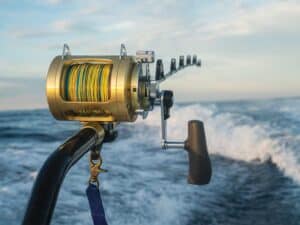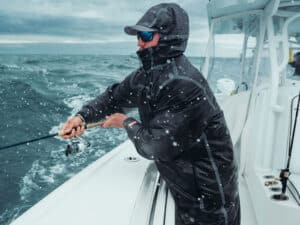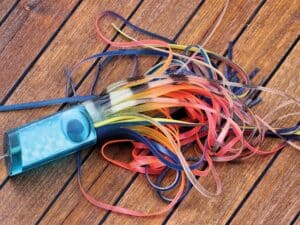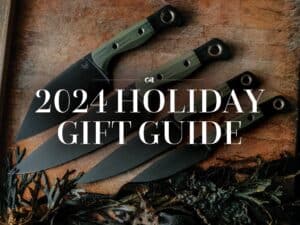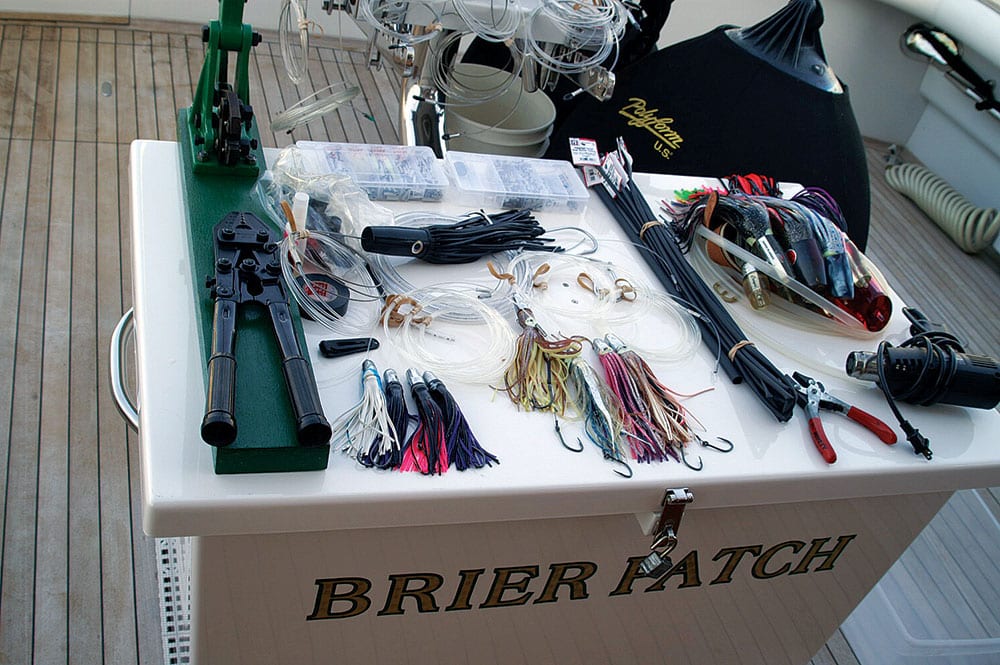
Every job goes easier with the proper tools, and working in the cockpit without the right tools proves difficult at best. You need to be fully dialed in and ready for the bite when it happens. From the simplest pair of pliers to a multitude of crimpers, wire cutters, rigging needles, line cutters and strap wrenches, today’s deckhands should have everything they need to rig tackle, baits and lures, make bait-catching rigs — you name it. Knowing when to use them, how to use them and how to care for them sets apart the pros from the guys just getting by.
I hate opening tackle drawers to find pliers, sharpening files or crimpers rusted to where they no longer work. On the other hand, it amazes me how many mates don’t even have a set of their own pliers and a bait knife, let alone actually wear a sheath with pliers while fishing. I find it unacceptable for a deckhand to lack the most basic tools needed to perform their duties.
Must-Have Pliers
Show me a deckhand who thinks he can quickly catch bait, de-hook a fish, cut mono or wire leaders, or trim ends on double lines without pliers at his side, and I’ll show you an unprepared and slow deckhand. Having pliers on the rocket launcher or tackle center is not the same — leaving them lying around slows down every process. Unless you strictly lure fish in St. Thomas in the Virgin Islands or something similar, every deckhand should have a proper set of pliers at their side.
Frequently, these same deckhands are the ones who throw their tools in the tackle drawer without spraying them with lubricant or making some effort to maintain them so they are ready when needed and have some longevity. As a freelance mate for many years, I prided myself on having my own equipment kit that I brought with me every day, filled with gear like crimps, as well as several different sets of crimpers, wire, mono leader, chafe gear, knives, files, floss, wax line, rigging needles, barrel swivels, snap swivels, rigging beads and pretty much anything else I needed. I also brought along a full set of lures. Oftentimes I jumped on a boat and they didn’t have what we needed, but I did.
One change since the 1970s, when I started, concerns the amount of specialized rigging gear now available. When I first started as a mate on a local bluefish charter boat, I got my first set of Sargent side-cutter pliers, an awesome piece of equipment I still have today. But now we also have several sets of Manley 6.5-inch Super Pliers for cutting wire and quick mono cuts, as well as several pairs of specialty pliers, including a lightweight pair of Black Watch 7.5-inch needle-nose carbide cutters for braid and mono. They are also great for de-hooking any fish.
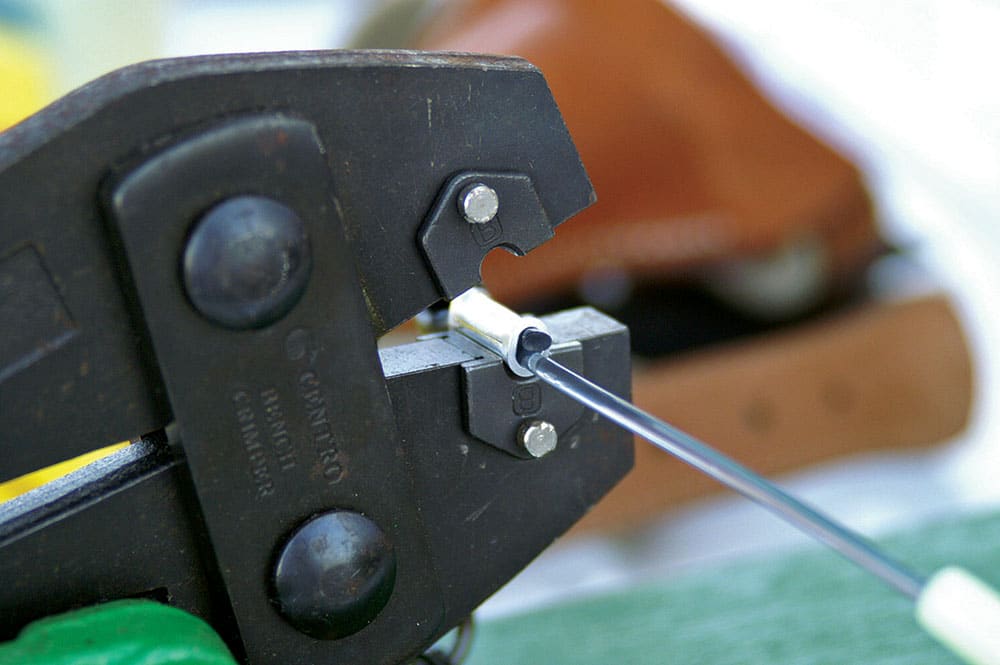
Crimp It
With the popularity of lure fishing, the increasing use of crimps and crimpers has led to a wide variety of tools made to match the crimp-to-mono and the crimper-to-crimp connection correctly. I carry several sets of hand crimpers, including a green one from Jinkai with the larger crimp die on the outside and the smaller die in the jaws. I use these to crimp my outrigger clips on and also to spread the wire on dredges, making it easy to put swivels on.
The other two sets of crimpers come from SeaStriker under the Billfisher brand. There’s a hand crimper that offers a clean swage for crimps from 0.5 to 2.2 mm in three positions; the other is a set of large hand swages for crimps from 1.0 to 4.2 mm in four positions that has a heat-treated satin-finish on the jaws, chrome-plated bolts and an epoxy finish on the handles, which offers excellent saltwater protection.
My Momoi bench crimper has removable dies, so I can change the die to match the crimp, and the tension is always set properly. We did a lot of testing to get it to the maximum without crushing the mono or not crimping enough. This adjustability is a great thing in helping to reduce rigging fluctuations.
Cutters for Every Type of Material
You also need a good set of cable cutters and non-mashing mono cutters. I prefer the larger hand cutters that allow us to carefully cut the 7-by-7 or 7-by-19 stainless-steel cable that we use to rig our trolling lures. Without these proper cutters, the cable gets mashed and pulled, and the strands unravel. I also use a set of super-sharp precision cutters for mono that will not smash the mono, cutting it smoothly and allowing the crimp to slip on easily.
Every deckhand should have perfected tying the haywire twist and the barrel wrap without aid from pliers for wire from No. 4 to No. 15. Years back, deckhands had to twist No. 19 wire for giant tunas and black marlin, a skill top-tier deckhands should still master. Among the other skills I would consider pertinent is the ability to make wind-ons of various sizes. To do this, we use a kit from Ex-Tex Tackle called the Quick Shot Wind-On needle set. This kit of hollow tubular needles allows you to splice Dacron and Spectra, and run mono into these hollow-core lines from 50- to 650-pound-test.
Bait rigging amounts to an art form when done right. Top deckhands can rig a host of dead baitfish to swim like they are still alive. Having the right sewing needles makes this job possible. Naturally, different types of needles work for different types of rigging. Generally, the Rite Angler 4- and 6-inch mortician’s needles are preferred. The long 9-inch needle comes in handy for sewing larger baits like bonito, Boston mackerel and eels. Live-baiters use a split-eye needle to bridle their baits, or sometimes they run Dacron onto a needle and glue it, leaving a tag end they tie to the bridle to pull through. This works well for live‑baiting large tunas and bonitos.
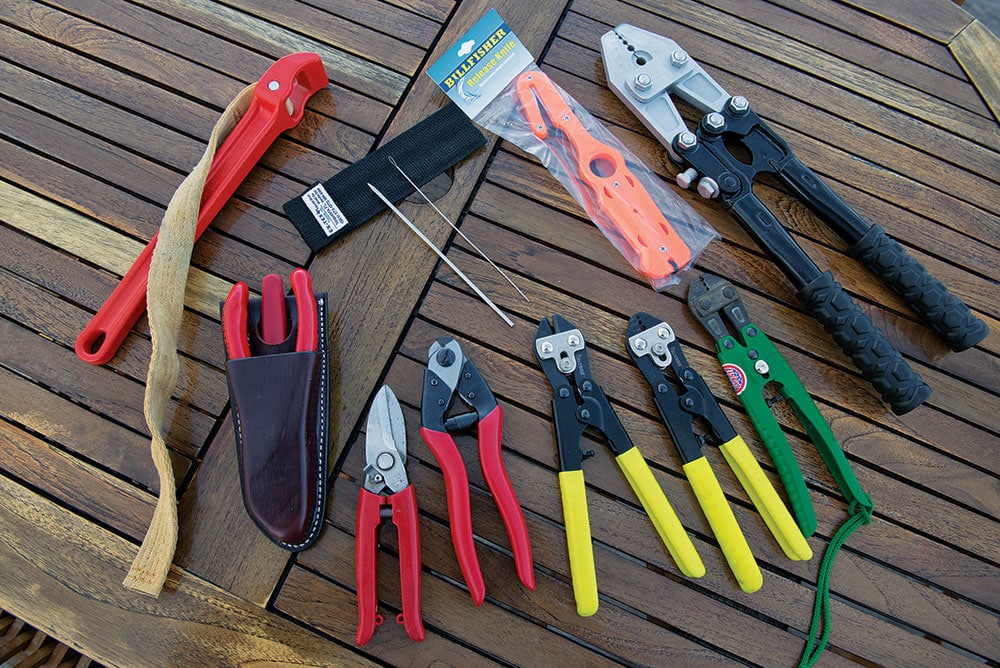
Hand Protection
The best wiremen I know all have wiring gloves that are like old friends. They are made for the task, broken in, comfortable, and they fit, well, like a glove. Aftco makes a host of excellently engineered gloves from light-duty to heavy-duty big-fish wiring gloves. Obadu wireman’s gloves are also a great choice for big fish on the leader, but whatever way you choose to go, a deckhand without gloves is like a firefighter without a hose: Neither can do his job.
A Place for Everything
Plenty of tools exist to help do the job right. Manufacturers like Boone, SeaStriker, Momoi, Rite Angler, Manley and others have a host of great products designed to accomplish a task properly. Once you have them, make sure you wash them and spray them with a lubricant after a day’s use if you have left them out in the cockpit while fishing. Salt mist and spray can be kept at bay with a little care and preventive maintenance.
When not fishing for a week or longer, remove the tools from the cockpit drawers and store them inside, out of the salt air, to help keep them working properly for a long period of time. And the next time you hire a deckhand for a couple of days, you’ll know a whole lot about how serious and dedicated he is by the gear he brings aboard to do his job. A pro will have a checklist of what tools he needs for the fishing trip at hand, and if the boat doesn’t have one, he’ll bring his or get it for the boat. At a minimum, he ought to have a set of pliers on his belt, a billfish-release knife and his own set of gloves if he is going to be on the leader.
